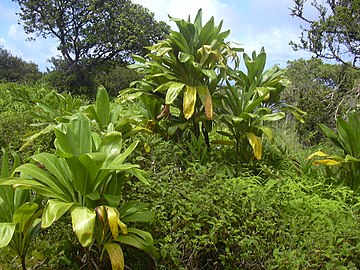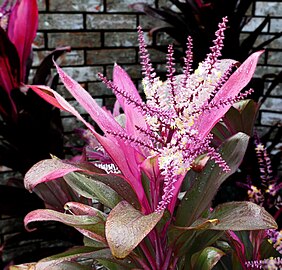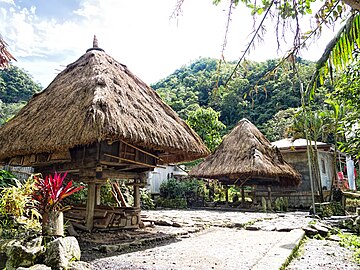Cordyline fruticosa
| Cordyline fruticosa | |
|---|---|
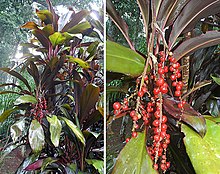
| |
| Foliage and fruit | |
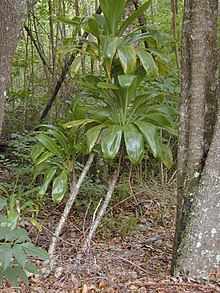
| |
| Green C. fruticosa in Makawao Forest Reserve, Maui | |
| Scientific classification | |
| Kingdom: | Plantae |
| Clade: | Tracheophytes |
| Clade: | Angiosperms |
| Clade: | Monocots |
| Order: | Asparagales |
| Family: | Asparagaceae |
| Subfamily: | Lomandroideae |
| Genus: | Cordyline |
| Species: | C. fruticosa
|
| Binomial name | |
| Cordyline fruticosa (
A.Chev. | |
| Synonyms[1] | |
|
| |
Cordyline fruticosa is an
Description
It is a palm-like plant growing up to 4.5 metres (15 feet) tall
-
Specimens in Maui
-
Green specimen
-
Purple specimen
-
Red specimen inButon Island
-
Variegated specimen
-
Specimen with fruit
-
Blossom,Gulf Coast of Texas
-
Inflorescence
-
Berries
Taxonomy
Cordyline fruticosa was formerly listed as part of the families Agavaceae and Laxmanniaceae (now both subfamilies of the Asparagaceae in the APG III system).
Names
The reconstructed
In the
Distribution and history
Its original native distribution is unknown, but it is believed to be native to the region from
It was carried throughout Oceania by Austronesians, reaching as far as
It was introduced to Europe as a houseplant in 1771.[9]
Uses
Socio-cultural and spiritual uses
It has many uses but it is most notable as one of the most important plants related to the indigenous socio-cultural practices of the Pacific and Island Southeast-Asia. In particular, it was propagated throughout the Austronesian linguistic area by humans, not so much for its food value (although some forms are edible) but mainly for socio-cultural reasons.[7] It is widely regarded as having mystical and spiritual importance in various cultures. It is common planted on grave sites, used in magical and ritual practices, including for healing.[10] It is also used as a decorative attire and ornamentation, and as a boundary markers. It is common for the red and green cultivars to be used differently in rituals. Red ti plants commonly symbolize blood, war, and the ties between the living and the dead; while green ti plants commonly symbolize peace and healing.[11][12][13] Their ritual uses in Island Southeast Asia have largely been obscured by the introduction of Hinduism, Buddhism, Islam, and Christianity, but they still persist in certain areas or are co-opted for the rituals of the new religions.[11]
In
In
In Island Melanesia, ti are regarded as sacred by various Austronesian-speaking peoples and are used in rituals for protection, divination, and fertility.[11] Among the Kwaio people, red ti are associated with feuding and vengeance, while green ti are associated with ancestor spirits, markers of sacred groves, and wards against evil. The Kwaio cultivate these varieties around their communities.[36] Among the Maenge people of New Britain, ti leaves are worn as everyday skirts by women. The color and size of leaves can vary by personal preference and fashion. New cultivars with different colors are traded regularly and strands of ti are grown near the village. Red leaves can only worn by women past puberty. Ti is also the most important plant in magic and healing rituals of the Maenge. Some ti cultivars are associated with supernatural spirits and have names and folklore around them.[37] In Vanuatu, Cordyline leaves, known locally by the Bislama name nanggaria, are worn tucked into a belt in traditional dances like Māʻuluʻulu, with different varieties having particular symbolic meanings. Cordylines are often planted outside nakamal buildings.[38] In Fiji, red ti leaves are used as skirts for dancers and are used in rituals dedicated to the spirits of the dead. They are also planted around ceremonial buildings used for initiation rituals.[11]
In Micronesia, ti leaves are buried under newly built houses in Pohnpei to ward of malign sorcery.[29] In instances of an unknown death, shamans in Micronesia communicate with the dead spirit through ti plants, naming various causes of death until the plant trembles.[7] There is also archaeological evidence that the rhizomes of the plants were eaten in the past in Guam prior to the Latte Period.[39]
In Polynesia, green ti were cultivated widely for food and religious purposes. They are commonly planted around homes, in sacred places (including marae and heiau), and in grave sites. The leaves are also carried as a charm when traveling and the leaves are used in rituals that communicate with the species. Like in Southeast Asia, they are widely believed to protect against evil spirits and bad luck; as well as having the ability to host spirits of dead people, as well as nature spirits.[5][7][40]
In
In Aotearoa, certain place names are derived from the use and folklore of ti, like Puketī Forest and Temuka. The ti plants in Kaingaroa are known as nga tī whakāwe o Kaingaroa ("the phantom trees of Kaingaroa"), based on the legend of two women who were turned into ti plants and seemingly follow people traveling through the area.[40]
-
Ti plants as wedding decoration in Cirebon
-
Red ti planted alongside traditional houses of the Ifugao people in the Banaue Rice Terraces, Philippines
-
Red ti planted around traditionalToraja houses in Tana Toraja, Sulawesi
-
Offerings of stone and bundles of ti leaves (puʻolo) in the Puʻu Moaulanui heiau (temple) in the summit of Kahoʻolawe, Hawaii
-
Lāhainā, in traditional kī leaf skirts
-
Ti leaf bundles (puʻolo) used as offerings to spirits in Hawaii
Other uses

The roots and young leaves can be cooked and eaten as survival food. The leaves can make a rain cloak.
Cordyline fruticosa flowers are a traditional treatment for asthma, and their anthocyanin content has been assessed to see if they might be commercial herbal remedy.[44]
In the Philippines, the roots were used to flavor the traditional
In Polynesia, the leaves of the green-leafed form are used to wrap food, line
Ti is a popular ornamental plant, with numerous cultivars available, many of them selected for green or reddish or purple foliage.
See also
- Domesticated plants and animals of Austronesia
- Samoan plant names
References
- ^ "Cordyline fruticosa". Germplasm Resources Information Network. Agricultural Research Service, United States Department of Agriculture. Retrieved 2009-11-17.
- ^ )
- ^ S2CID 146739541.
- ^ "*Tï". Te Mära Reo: The Language Garden. Benton Family Trust. Retrieved 15 January 2019.
- ^ PMID 21636452.
- ^ Philip, Simpson (9 September 2012). "Cordyline fruticosa (ti plant)". Invasive Species Compendium. Centre for Agriculture and Bioscience International. Retrieved 19 January 2019.
- ^ a b c d Hinkle, Anya E. (2004). "The distribution of a male sterile form of ti (Cordyline fruticosa) in Polynesia: a case of human selection?" (PDF). The Journal of the Polynesian Society. 113 (3): 263–290. Archived from the original (PDF) on 2022-07-05. Retrieved 2019-01-19.
- ^ Trisha, Borland (2009). "Cordyline fruticosa: the distribution and continuity of a sacred plant" (PDF). UCB Moorea Class: Biology and Geomorphology of Tropical Islands. Student Research Papers, Fall 2009. University of California.
- OCLC 155682753.
- ^ .
- ^ a b c d e f g h Ehrlich, Celia (2000). "'Inedible' to 'edible': Firewalking and the ti plant [Cordyline fruticosa (L.) A. Chev.]". The Journal of the Polynesian Society. 109 (4): 371–400. Archived from the original on 2019-12-01. Retrieved 2019-01-21.
- ^ Ehrlich, Celia (1989). "Special problems in an ethnobotanical literature search: Cordyline terminalis (L.) Kunth, the "Hawaiian ti plant"" (PDF). Journal of Ethnobiology. 9 (1): 51–63.
- ^ ISBN 9781478610021.
- ^ van Schooneveld, Inge (18 July 2018). "Punnuk rice harvest ritual celebrates the Earth's abundance". Sinchi. Retrieved 19 January 2019.
- ^ de Guzman, Daniel (6 July 2018). "Flora De Filipinas: A Short Overview of Philippine Plant Lore". The Aswang Project. Retrieved 19 January 2019.
- ^ Harvest Rituals in Hapao (PDF). Social Practices, Rituals and Festive Events. International Information and Networking Centre for Intangible Cultural Heritage in the Asia-Pacific Region under the auspices of UNESCO (ICHCAP). Archived from the original (PDF) on 2018-09-09. Retrieved 2019-01-21.
- .
- ^ Novellino, Dario (2001). "Palawan Attitudes Toward Illness" (PDF). Philippine Studies. 49 (1): 78–93.
- ^ Gunawan (2013). "Study Ethnobotany Andong Plants of the Genus Cordyline in the Dayaknese of Meratus Lok Lahung Village, Loksado, South Borneo". 4th International Conference on Global Resource Conservation & 10th Indonesian Society for Plant Taxonomy Congress. Brawijaya University. Archived from the original on 2020-01-26. Retrieved 2019-01-21.
- ^ a b Rahayu, Mulyati; Rustiami, Himmah; Rugayah (2016). "Ethnobotanical Study of Sasak Ethnic, East Lombok, West Nusa Tenggara" (PDF). Journal of Tropical Biology and Conservation: 85–99.
- .
- ^ Hakim, Nurul (2006). Cultural and Spiritual Values of Forests in Bady Region, Banten, Indonesia. MSc Forest and Nature Conservation Policy. Wageningen University.
- .
- ISBN 9789004274075.
- ^ Sumantera, I. Wayan (1999). "Plants Intertwined with Culture". Roots. 1 (19). Archived from the original on 2019-01-19. Retrieved 2019-01-21.
- ISBN 9789401771504.
- ISBN 9780252011832.
- ISBN 9781920942847.
- ^ .
- ISBN 9780822388067.
- ISBN 9780521852418.
- JSTOR 3772735.
- .
- ^ Hill, Rowena Catherine (2011). Colour and Ceremony: the role of paints among the Mendi and Sulka peoples of Papua New Guinea (MSc). Durham University.
- ISBN 9781921666018.
- S2CID 143871873.
- ISBN 9782956398189.
- ISBN 9780956098542.
- ^ Moore, Darlene R. (2005). "Archaeological Evidence of a Prehistoric Farming Technique on Guam" (PDF). Micronesica. 38 (1): 93–120.
- ^ .
- ^ Kawate, M.; Uchida, J.; Coughlin, J.; Melzer, M.; Kadooka, C.; Kam, J.; Sugano, J.; Fukuda, S. (2014). "Ti Leaf (Cordyline terminalis or fruticosa) Diseases in Hawaii's Commercial Orchards" (PDF). HānaiʻAi/The Food Provider: 1–11. Archived from the original (PDF) on 2015-12-10. Retrieved 2019-01-21.
- ^ Gamayo, Darde (4 August 2016). "Ti Leaf: Canoe Plant of Ancient Hawai'i". Big Island Now. Retrieved 21 January 2019.
- ^ Da Silva, Alexandre (24 July 2005). "Thrill ride". Star Bulletin. Retrieved 21 January 2019.
- S2CID 218954103.
- ^ Garvan, John M. (1912). "Report on the drinks and drinking among the Mandaya, Manobo, and Mangguangan Tribes". The Philippine Journal of Science: Section A. 7: 106–114.
- Eater. Retrieved 21 January 2019.
- ^ Griffith, Robert Eglesfeld (1847). Medical Botany. Lea and Blanchard. p. 655.
External links
- Flora of China: Cordyline fruticosa
- Sir Queen's Representative (1990–2000) dressed in tī leaves. [1]
- Comparative Awareness: Modified Leaves of Cordyline fruticosa manifest at the same time with Poinsettia by Isidro A. T. Savillo

